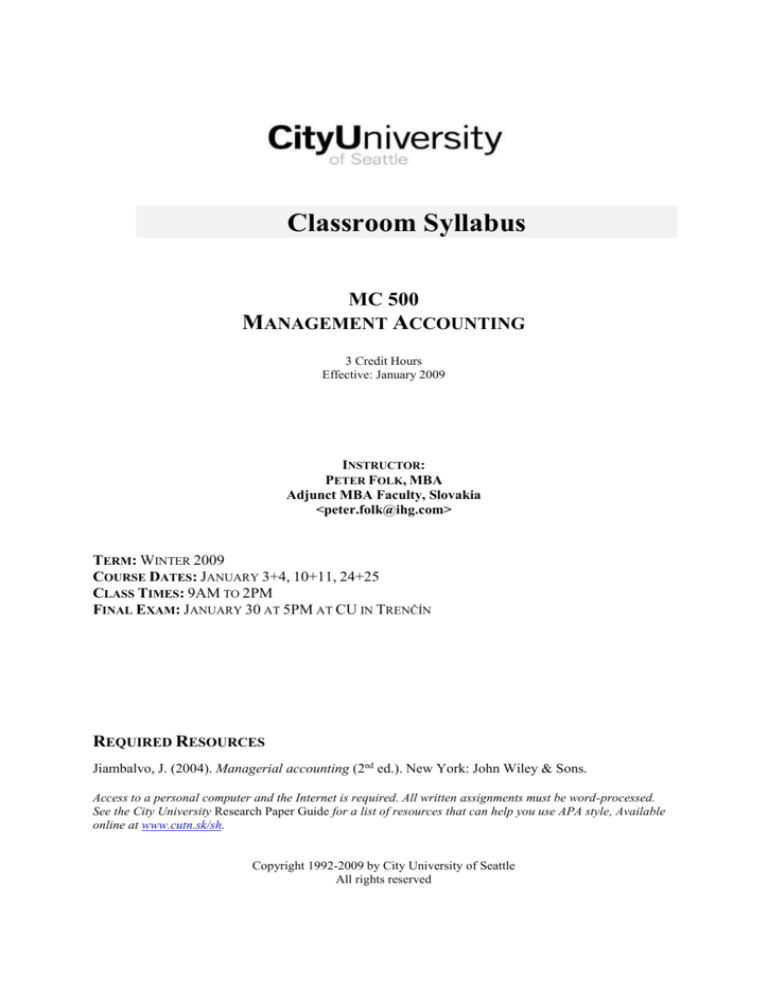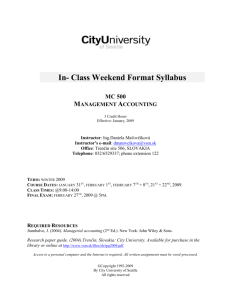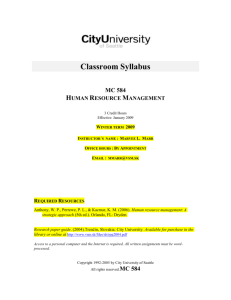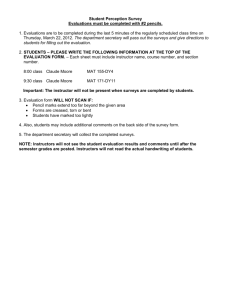
Classroom Syllabus
MC 500
MANAGEMENT ACCOUNTING
3 Credit Hours
Effective: January 2009
INSTRUCTOR:
PETER FOLK, MBA
Adjunct MBA Faculty, Slovakia
<peter.folk@ihg.com>
TERM: WINTER 2009
COURSE DATES: JANUARY 3+4, 10+11, 24+25
CLASS TIMES: 9AM TO 2PM
FINAL EXAM: JANUARY 30 AT 5PM AT CU IN TRENČÍN
REQUIRED RESOURCES
Jiambalvo, J. (2004). Managerial accounting (2nd ed.). New York: John Wiley & Sons.
Access to a personal computer and the Internet is required. All written assignments must be word-processed.
See the City University Research Paper Guide for a list of resources that can help you use APA style, Available
online at www.cutn.sk/sh.
Copyright 1992-2009 by City University of Seattle
All rights reserved
MC 500
MANAGEMENT ACCOUNTING
This document provides an overview of the course foundation elements, assignments, schedules and
activities. For information about general City University of Seattle policies, please see the City
University of Seattle catalog. If you have additional questions about the course, please contact your
instructor.
COURSE DESCRIPTION
Students will study the role of financial accounting in a corporate setting and learn how to analyze
publicly issued financial statements for decision-making. You will also study techniques for analyzing
internal accounting data for making costing, pricing, production, and investment decisions. This
includes budgeting, cost behaviors, cost-volume-profit analysis, investment decisions, and
responsibility accounting. It is strongly recommended for the student to have a firm basis in
quantitative analysis (MC 506) and well-developed communication skills (MC 511) before studying
management accounting. MC 500 introduces the concepts and techniques of financial analysis.
COURSE OVERVIEW
This course is designed to introduce the fundamental requirements of financial reporting and the role
of the accounting function in management planning and control. The objective is to teach you how to
use financial statements and other financial reports rather than how to prepare them.
MC 500 is divided into two parts. The first part examines the basis for financial statement
development primarily from a corporate finance perspective, including the role and responsibilities of
the independent auditor. The primary focus is on the fair presentation of financial position and
operating performance to external parties. The second part covers various accounting and related
analytical techniques that can assist management in making well-informed decisions about internal
operations. Appropriate analysis of financial and cost data will be addressed from a management
perspective. Emphasis will be placed on the use of these analyses to improve planning, productivity,
and overall profitability.
City University of Seattle teaches from a business management perspective. It is presumed that as a
City University of Seattle student, you are able to write, think and articulate concepts at a
graduate level; that you will take responsibility for reading assigned materials; and that you will
be prepared to apply these concepts in the assignments that you submit.
LEARNING GOALS
Upon the successful completion of this course, you will be able to:
1. Evaluate financial reporting alternatives based on Generally Accepted Accounting Principles
(GAAP);
2. Analyze the respective roles and responsibilities of management and the external auditor in
developing and examining financial statements;
3. Evaluate the effect of management decisions and resulting transactions on the financial
statements, using key financial accounting principles and the accounting equation;
4. Evaluate firm liquidity, profitability, debt management, cash position and asset management
based on interpretation of the published financial statements of a firm;
5. Select relevant data from internal accounting reports for investment, production and pricing
decisions;
6. Formulate cost control, pricing, and production strategies, based on appropriate management
analysis techniques;
MC 500
SYL
Page 2
Eff: 01/09
7. Apply time value of money concepts to capital investment decisions;
8. Describe how the underlying concepts, techniques, analyses, and methods of accounting support
management decision-making;
9. Identify the four financial statements;
10. Identify the relationships of the financial statements and describe the effect that transactions have
on each statement.
CORE CONCEPTS
In order to achieve the goals of this course, you must master the following core concepts:
1. Accounting equation;
2. Transaction analysis using the accounting equation;
3. Principles of historical cost, periodicity, business entity, matching, revenue recognition,
conservatism, and objectivity;
4. Role of the independent auditor and function of audit report in the annual report;
5. Relationships among the four basic financial statements;
6. Objectives and content of the four basic financial statements;
7. Types of business entities and the accounting implications;
8. Terms and relationship among items in the stockholders’ equity section;
9. Ratio analysis;
10. Cost terms;
11. Cost behaviors;
12. Flow of costs in a job order cost system;
13. Cost-volume-profit analysis;
14. Nature and relevance of various types of cost;
15. Incremental analysis;
16. Budgeting, variance analysis, and contribution margin;
17. Cost variance analysis.
RECOMMENDED SUPPLEMENTARY RESOURCES
As a City University of Seattle student, you have access to library resources regardless of where and
how you are taking this class. To access the resources that are necessary to complete your coursework
and assignments, visit the library menu in the My.CityU portal at http://my.cityu.edu or the Slovakia
library site at http://library.cutn.sk/
A good place to begin your research is through the program resource sections that provide links to
relevant journals, books, and Web sites. Search the Slovakia library's online catalog to locate books
and videos. Search the online databases for journal, magazine, and newspaper articles. Articles that
are not available full text in the library's collection can be requested from other libraries and delivered
to you electronically. For additional help, submit your question via the Ask a Librarian e-mail
service available through the portal or the Contact Us section on the Slovakia library site.
PRINT RESOURCES
The following professional journals feature scholarly articles of substantial length on management
accounting:
MC 500
SYL
Page 3
Eff: 01/09
Accounting Review
Harvard Business Review
Journal of Accountancy
Journal of Accounting, Auditing and Finance
Journal of Accounting Research
Management Accounting
Strategic Finance
Practical Accounting
ELECTRONIC RESOURCES
The following Internet resources may be of use to you in this course. Please be aware that Web
addresses may change from time to time. Consult your instructor if you have questions about
electronic resources.
Babson, Researching an Industry, Composite Financial Statements and Ratios
http://www.babson.edu/library/indcomposite.htm
Edgar Online
http://www.edgar-online.com/
Journal of Finance
http://www.cob.ohio-state.edu/dept/fin/journal/jof.htm
Library Spot
http://www.libraryspot.com
Securities and Exchange Commission (SEC)
http://www.sec.gov
Wall Street Journal
http://www.wsj.com
MC 500
SYL
Page 4
Eff: 01/09
OVERVIEW OF COURSE ACTIVITIES AND GRADING
The grade you receive for the course will be derived using City University of Seattle’s decimal
grading system, based on the following:
Assignment
Financial Statement Analysis Research Paper
Comprehensive Problem
Final Examination
35%
25%
40%
TOTAL
100%
Please see the current City University of Seattle catalog or consult your instructor for guidance in
determining your decimal grade.
EXPLANATION OF ASSIGNMENTS AND GRADING
FINANCIAL STATEMENT ANALYSIS RESEARCH PAPER
Find an annual report of a publicly traded corporation on the Internet. The selection of the company is
up to your preferences, but the annual report must be available on-line and you must use the most
recent one.
Referring to the Annual Report and supplemented by your research, respond to the instructions and
questions below. Fully explain your answers by detailed explanation or calculations where necessary
and appropriate. All questions and instructions refer to the most recent year reported, unless otherwise
stated:
1. Provide an overview of the company, the type of business it engages in, and any significant recent
events affecting the company’s operations or financial position.
2. Discuss the auditor’s report, the role of the auditors, and the significance of the report to the
corporation and to the external users of the financial statements.
3. How many shares of common stock did the company have outstanding?
4. Does the company have any preferred stock outstanding?
5. What is the book value per share of common stock?
6. What is the company’s total paid-in capital?
7. What was the average price per share received by the Company for all common stock issued since
inception of the Corporation?
8. What was the total dollar amount of dividends declared in the most recent year reported?
9. Evaluate and comment on the following:
a. Liquidity – ability to meet short-term obligations as they come due;
b. Solvency – this should include short-term liquidity, asset management, debt management and
interest coverage
c. Profitability – this should include return on assets and equity, and earnings per share.
d. Cash position – this should include a discussion of the Cash Flow Statement, whether it is in
the direct or indirect format, and the primary sources and uses of cash for the period.
10. How does the company’s performance compare to similar companies and/or industry standard?
11. Describe unique opportunities available to this company or industry. Has the company capitalized
on these opportunities?
12. What current or potential threats exist for this company or industry?
13. Based on all your analysis, what weaknesses, if any, do you see in the financial status, operating
performance, or cash position of the company, and what steps would you recommend for
improvement?
MC 500
SYL
Page 5
Eff: 01/09
You will be graded on the professional presentation as well as the completeness of your paper. This
includes proper internal source citation and bibliography format using the APA format. A Style
Guide is listed among required materials for this course and you are responsible for the requirements
described in it for APA format. APA (parenthetical format) should be used for your internal citations
and your list of references.
Support your discussion, opinions, and conclusions fully. Remember that evaluation requires some
comment and analysis, not just a computation of the ratios. At a minimum, you are expected to
use the ratios presented in your text. Be sure to show all computations. You should also use the
same formulas for the ratios used by the author of the text, unless you explain why you are
using a different version of the ratio.
Valid analysis requires comparison to industry averages. This research of the industry as a basis
for evaluating the ratios that you calculate is a major component of this assignment. You are
expected to include that industry data as a major part of your paper. Also, comparison to
industry average ratios requires that you actually present (and properly cite) the specific
industry data you are referring to. Several sources are listed below and in your text for that industry
research. You must use one or more of these sources for your industry ratio data. There are many
financial market websites where one can find financial data for various companies (such as
www.marketwatch.com). Many of those include some industry ratios. Industry data from these
sources is not acceptable. For this data, you must refer to the references on industry information
located in the library. Some of these are Value Line Investment Surveys, Standard and Poor’s Industry
Survey, Dun & Bradstreet Industry Norms and Key Industry Ratios, Robert Morris Associates,
Moody’s, or the Wall Street Journal. You are expected to do library research to find the industry
ratios. If your library resources are limited, contact the City University Library. They have at least two
of these sources. The City University library also has one of these appropriate sources on their on-line
library.
One of the objectives of this assignment is to give you some exposure to actual financial statements,
such as those that you might encounter in a business setting. In many cases, actual financial
statements may contain terminology, or non-typical items that are not covered in the textbook. You
are encouraged to research other sources and do some additional reading to learn about any
unusual items you may see.
Respond to the directions as fully and completely as you can. Some questions or instructions will
require more explanation than others will. Comparison to industry ratios and averages requires that
you actually state the specific industry data to which you are referring.
Grading Criteria for Financial Statement Analysis Research Paper
Accuracy of calculations to support analysis
Validity and completeness of analysis
Responds to all questions and instructions
Sufficient depth of research
Understanding of course concepts is demonstrated in responses
Conclusions are logical, valid and clearly stated
Conclusions and opinions supported by appropriate analysis and/or
proper source citations
All computations are clearly presented
There is internal consistency among answers
Professional presentation
Proper list of References in APA format
Proper internal citations accompanying all data presented from other
sources, in APA format
All narrative double-spaced
Proper title page
Grammar, spelling and syntax
TOTAL
MC 500
SYL
Page 6
Eff: 01/09
25%
50%
10%
15%
100%
COMPREHENSIVE PROBLEM
Your instructor will assign the comprehensive problem either from your textbook or from another
source. Follow the problem instructions and answer the questions as fully as you can. Show all
computations in good form. Your problem solution should be typed, word-processed or prepared on a
computer spreadsheet as appropriate. It should be prefaced by a proper title page, and pages should be
numbered.
Grading Criteria for Comprehensive Problem
Accuracy and validity of solution
Completeness of responses
Format and organization of solution
Professional presentation/ grammar/ syntax/ spelling
50%
25%
15%
10%
TOTAL
100%
EXAMINATIONS
The Final Exam will be closed book. You will be allowed to use one A4 format sheet of notes.
The instructor may elect to provide interest tables where necessary, but you may have a financial
calculator during examinations. You are not allowed to use a computer during exams nor may you
have an electronic organizer, palm pilot, or any other electronic device that stores text data.
The Final Exam will be of maximum three hours. You should be prepared to answer or solve
multiple-choice questions (conceptual and computational), short answer questions, matching
questions and/or problems.
For any exam questions requiring computations, you must show all work, and label your
computations clearly. For both problems and computational multiple-choice questions, partial credit
may be earned based on well-labeled computations, even if the final answer is not correct. All work
must be done on the exam pages provided.
Your instructor will provide additional information about exams as necessary.
HOMEWORK ASSIGNMENTS
The Recommended Course Schedule includes a list of homework assignments from your textbook.
Completing all homework assignments and reading all the assigned material will help ensure
that you successfully master the concepts in this course. The best way for you to gain a thorough
understanding of the underlying concepts is to apply those concepts to solving the problems.
You should focus on the underlying accounting principles, rather than on just memorizing the steps to
solve a problem. A certain amount of memorizing is necessary initially, but memorized facts and
definitions alone will not allow you to learn the concepts taught in this course. The homework
assignments are not graded. Homework problems will be covered in class only as time permits.
A suggested study strategy for each week’s assignment is:
1) Read the assigned chapters in the text;
2) If applicable (for the first half of the course) complete the related self-test in the Fraser text
and check against the answers in the Appendix to the text;
3) Do the assigned exercises and problems and refer to the solutions for feedback. Contact your
instructor if you are still having trouble understanding a solution.
MC 500
SYL
Page 7
Eff: 01/09
PROFESSIONAL PRESENTATION OF WRITTEN WORK
All assignments submitted for this course should be of professional quality. The student should
present each paper in a format that would be appropriate for submitting to upper management.
This course requires that you use the American Psychological Association (APA) style in preparing
any written work where sources are used. A recommended style guide is included in the “Required
Text and Materials” section. Refer to this style guide for proper format, referencing methods, and
bibliographic format. References should be cited in the body of your paper accompanying each fact,
idea, conclusion, and opinion not your own. Not to do so is considered plagiarism. Do not list course
textbooks in the bibliography but if a citation is made from the textbook, include a reference in the
narrative of the paper, including the page number in the textbook from which the information was
taken.
The first page of all written assignments should be a proper title page, unless the instructor states
other requirements. The title page must include: your name, the title of the paper, the name and
number of the course, the date submitted and the name of the instructor.
Your work should be typed or word-processed on white A4 format paper and all narrative portions
should be double spaced. Some assignments may require that your work be prepared on a computer
spreadsheet.
Do not use binders or special covers when submitting your assignments. Staple your completed
assignments in the upper-left hand corner. Your instructor may have different or additional
requirements for the submission of written work.
Please see the current City University catalog or consult your instructor for guidance in determining
your decimal grade.
SCHOLASTIC HONESTY
City University of Seattle expects each student to do his/her own work. The University has "zero
tolerance" for cheating, plagiarism, unauthorized collaboration on assignments and papers, using
"notes" during exams, submitting someone else's work as one's own, submitting work previously
submitted for another course, or facilitating acts of academic dishonesty by others. The penalties are
severe! A first offense can result in a zero grade for the course and suspension for one quarter; a
second offense can result in a zero grade for the course and suspension for two or more quarters; a
third offense can result in expulsion from the University. The Policy and Procedures may be found at
http://www.vsm.sk/en/students/scholastic-honesty/policies-and-procedures/.
In addition to providing your work to the instructor for grading, you must also submit an electronic
copy for the CU archives (unless the work is specifically exempted by the instructor). You will not
receive a grade for particular work until and unless you submit this electronic copy. The procedure
for submitting work to the archives is to upload it via the website http://www.vsm.sk/en/students/online-center/uploader/uploader.html. Files should include the cover page of the work with the student
name, instructor name, course name and number, and date. File names should indicate the type of
assignment, such as “researchpaper.doc”, “casestudy.doc” or “thesis.doc” (student name should not be
a part of the file name because the system adds it). All files received into the archives are submitted
to www.TurnItIn.com for plagiarism checking.
MC 500
SYL
Page 8
Eff: 01/09
RECOMMENDED COURSE SCHEDULE
The schedule for course activities and assignments is below. If you find you are unable to complete
the assignments as scheduled, contact your instructor. Your instructor may elect to adjust the outline
to meet the unique needs of the class.
Ex. = Exercise
SESSION
1
January 3,
2009
2
January 4,
2009
3
January
10, 2009
4
January
11, 2009
5
January
24, 2009
6
January
25, 2009
Friday,
Jan 30th
P = Problem
TOPICS AND ASSIGNMENTS
READINGS
Introduction to Accounting
Managerial Accounting in the Information Age
Jiambalvo, Chapter 1
P. 1-1, 1-2, 1-6
Analyzing Financial Statements: A Managerial Perspective
Jiambalvo, Chapter 13
Ex. 13-6 through 13-11
P. 13-6
Job-Order Costing and Modern Manufacturing Practices
Jiambalvo, Chapter 2
Ex. 2-4, 2-5, P 2-2
Process Costing
Jiambalvo, Chapter 3
Ex. 3-6, P 3-1
Cost-Volume-Profit Analysis
Jiambalvo, Chapter 4
Ex. 4-8, P 4-1, 4-5
Variable Costing
Jiambalvo, Chapter 5
Ex. 5-4 through 5-10,
P. 5-5
Cost Allocation and Activity-Based Costing
Jiambalvo, Chapter 6
Ex. 6-5, 6-7, 6-9
The Use of Cost Information in Management Decision
Jiambalvo, Chapter 7
Ex.7-5, 7-7, 7-10
Pricing Decisions, Analyzing Customer Profitability, And
Activity-Based Pricing
Jiambalvo, Chapter 8
Ex. 8-4, 8-5, 8-8
Capital Budgeting Decisions
Jiambalvo, Chapter 9
Ex. 9-9, 9-11, 9-12
P. 9-3, 9-11
Budget Planning and Control
Jiambalvo, Chapter 10
Ex. 10-5, 10-6, 10-12
Standard Costs and Variance Analysis
Jiambalvo, Chapter 11
Ex. 11-4, 11-5, 11-6, 11-13
Decentralization and Performance Evaluation
Jiambalvo, Chapter 12
Ex. 12-11, 12-12, 12-14
Course Review
Submit Financial Statement Analysis Research Paper
Submit Comprehensive Problem
Final Examination, Chapters 1-13 from Jiambalvo
MC 500
SYL
Page 9
Eff: 01/09







